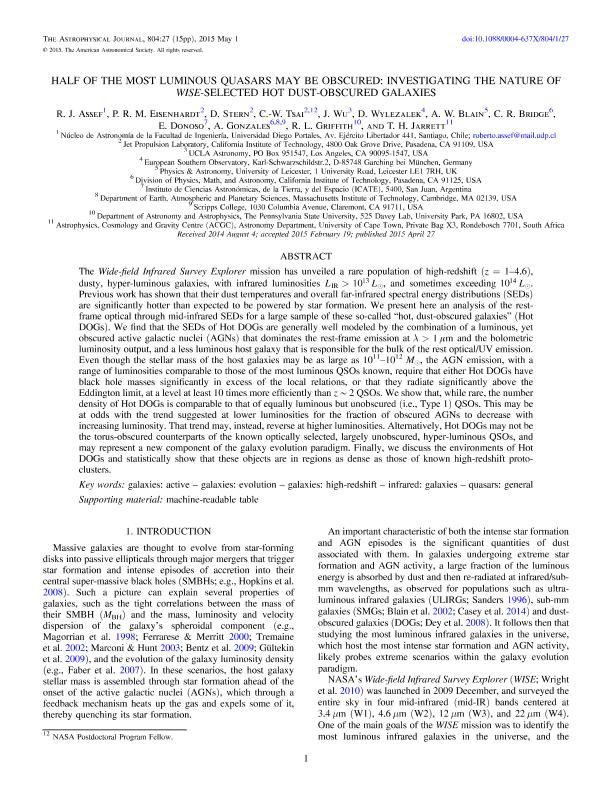Mostrar el registro sencillo del ítem
dc.contributor.author
Assef, R. J.
dc.contributor.author
Eisenhardt, P. R. M.
dc.contributor.author
Stern, D.
dc.contributor.author
Tsai, Chao Wei
dc.contributor.author
Wu, Jingwen
dc.contributor.author
Wylezalek, D.
dc.contributor.author
Blain, A. W.
dc.contributor.author
Bridge, C.
dc.contributor.author
Donoso, Emilio

dc.contributor.author
Gonzales, A.
dc.contributor.author
Griffith, R. l.
dc.contributor.author
Jarrett, T. H.
dc.date.available
2016-03-21T19:59:28Z
dc.date.issued
2015-05
dc.identifier.citation
Assef, R. J.; Eisenhardt, P. R. M.; Stern, D.; Tsai, Chao Wei; Wu, Jingwen; et al.; Half of the Most Luminous Quasars May Be Obscured: Investigating The Nature Of WISE-Selected Hot Dust-Obscured Galaxies; IOP Publishing; Astrophysical Journal; 804; 1; 5-2015; 1-15
dc.identifier.issn
0004-637X
dc.identifier.uri
http://hdl.handle.net/11336/4888
dc.description.abstract
The Wide-field Infrared Survey Explorer mission has unveiled a rare population of high-redshift (z = 1–4.6), dusty, hyper-luminous galaxies, with infrared luminosities LIR > 10 L 13 , and sometimes exceeding 10 L 14 . Previous work has shown that their dust temperatures and overall far-infrared spectral energy distributions (SEDs) are significantly hotter than expected to be powered by star formation. We present here an analysis of the restframe optical through mid-infrared SEDs for a large sample of these so-called “hot, dust-obscured galaxies” (Hot DOGs). We find that the SEDs of Hot DOGs are generally well modeled by the combination of a luminous, yet obscured active galactic nuclei (AGNs) that dominates the rest-frame emission at l > 1 μm and the bolometric luminosity output, and a less luminous host galaxy that is responsible for the bulk of the rest optical/UV emission. Even though the stellar mass of the host galaxies may be as large as 1011–1012 Me, the AGN emission, with a range of luminosities comparable to those of the most luminous QSOs known, require that either Hot DOGs have black hole masses significantly in excess of the local relations, or that they radiate significantly above the Eddington limit, at a level at least 10 times more efficiently than z ∼ 2 QSOs. We show that, while rare, the number density of Hot DOGs is comparable to that of equally luminous but unobscured (i.e., Type 1) QSOs. This may be at odds with the trend suggested at lower luminosities for the fraction of obscured AGNs to decrease with increasing luminosity. That trend may, instead, reverse at higher luminosities. Alternatively, Hot DOGs may not be the torus-obscured counterparts of the known optically selected, largely unobscured, hyper-luminous QSOs, and may represent a new component of the galaxy evolution paradigm. Finally, we discuss the environments of Hot DOGs and statistically show that these objects are in regions as dense as those of known high-redshift protoclusters.
dc.format
application/pdf
dc.language.iso
eng
dc.publisher
IOP Publishing

dc.rights
info:eu-repo/semantics/openAccess
dc.rights.uri
https://creativecommons.org/licenses/by-nc-sa/2.5/ar/
dc.subject
Galaxies
dc.subject
Infrared
dc.subject
Quasars
dc.subject.classification
Astronomía

dc.subject.classification
Ciencias Físicas

dc.subject.classification
CIENCIAS NATURALES Y EXACTAS

dc.title
Half of the Most Luminous Quasars May Be Obscured: Investigating The Nature Of WISE-Selected Hot Dust-Obscured Galaxies
dc.type
info:eu-repo/semantics/article
dc.type
info:ar-repo/semantics/artículo
dc.type
info:eu-repo/semantics/publishedVersion
dc.date.updated
2016-03-30 10:35:44.97925-03
dc.journal.volume
804
dc.journal.number
1
dc.journal.pagination
1-15
dc.journal.pais
Reino Unido

dc.journal.ciudad
Londres
dc.conicet.avisoEditorial
© 2015. The American Astronomical Society
dc.description.fil
Fil: Assef, R. J.. Universidad Diego Portales; Chile
dc.description.fil
Fil: Eisenhardt, P. R. M.. California Institute of Technology. Jet Propulsion Laboratory; Estados Unidos
dc.description.fil
Fil: Stern, D.. California Institute of Technology. Jet Propulsion Laboratory; Estados Unidos
dc.description.fil
Fil: Tsai, Chao Wei. California Institute of Technology. Jet Propulsion Laboratory; Estados Unidos
dc.description.fil
Fil: Wu, Jingwen. UCLA Astronomy; Estados Unidos
dc.description.fil
Fil: Wylezalek, D.. European Southern Observatory; Alemania
dc.description.fil
Fil: Blain, A. W.. University Of Leicester; Reino Unido
dc.description.fil
Fil: Bridge, C.. California Instituto Of Technology; Estados Unidos
dc.description.fil
Fil: Donoso, Emilio. Consejo Nacional de Investigaciones CientiÂficas y Tecnicas. Centro Cientifico Tecnologico San Juan. Instituto de Ciencias Astronomicas de la Tierra y del Espacio; Argentina
dc.description.fil
Fil: Gonzales, A.. California Instituto Of Technology; Estados Unidos. Massachusetts Institute of Technology; Estados Unidos. Scripps College; Estados Unidos
dc.description.fil
Fil: Griffith, R. l.. The Pennsylvania State University. Department of Astronomy and Astrophysics; Estados Unidos
dc.description.fil
Fil: Jarrett, T. H.. University of Cape Town. Astronomy Department. Astrophysics, Cosmology and Gravity Centre; Sudáfrica
dc.journal.title
Astrophysical Journal

dc.relation.alternativeid
info:eu-repo/semantics/altIdentifier/url/http://iopscience.iop.org/article/10.1088/0004-637X/804/1/27/meta
dc.relation.alternativeid
info:eu-repo/semantics/altIdentifier/doi/http://dx.doi.org/10.1088/0004-637X/804/1/27
dc.relation.alternativeid
info:eu-repo/semantics/altIdentifier/doi/10.1088/0004-637X/804/1/27
dc.relation.alternativeid
info:eu-repo/semantics/altIdentifier/url/http://arxiv.org/abs/1408.1092
dc.relation.alternativeid
info:eu-repo/semantics/altIdentifier/arxiv/1408.1092
Archivos asociados
